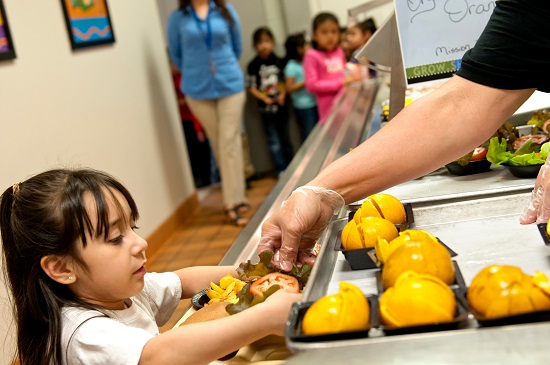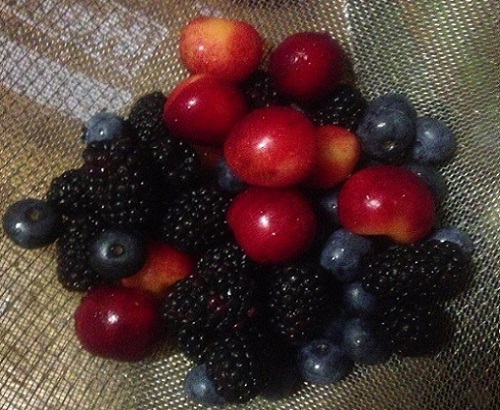Disclaimer: The information, recommendations, and inspirations found on this post are not intended to replace the advice of a qualified health care professional and are not intended as medical advice. They are solely for the purpose of sharing knowledge and information from the personal experience, research, and training of the author, Melinda Gonzalez.

When I learned that the USDA had designed a new meal plan for children in schools, I was ecstatic. I mean, really, excited. Had our government finally gotten with the program and realized that our children need to eat real, whole, non-GMO foods? Is it time to raise a generation without disease? Finally, parents trying to raise healthy children could be assured that packing school lunches was not a total necessity.
When I opened up the new plan after my healthy living friends were lauding it, disappointment washed over me. It’s been hard for U.S. parents to have faith in school lunches providing adequate nutrition since the Reagan administration declared that ketchup qualifies as a vegetable. Never mind the fact that the tomato is a fruit. But, alas, the USDA takes one step forward, but quite a few backwards.
Benefits
The beneficial changes from the prior menu are very miniscule. The main difference I have noticed is an attempt at food variety. On some days, there is a switch from pre-made applesauce to fresher fruits and vegetables.
The best day for the menu is, perhaps, Wednesdays when children are switched from pizza sticks to a salad.
I really tried hard to see more benefits with this menu, but I just could not find them.
Drawbacks
Low-Fat Ingredients
The new meal plan tailored to children is full of the same mythologies that have made U.S. citizens some of the most, if not the most, obese people in the world since the 1950s. Fat is considered the eternal enemy, so we must avoid it at all costs. The cost, now, is that we must give our children “low-fat,” “reduced-fat,” and “skim” everything so that they do not grow up struggling with obesity.
It is true that there are some types of “bad” fat, but those are usually man-made fats in the form of vegetable oils, like corn and canola. Fat is, actually, essential to the functioning of our bodies and brain development. I would urge the USDA to end the call to “fat-free,” which for me signals the exchange of natural fats with chemicals and artificial ingredients, and move towards a REAL foods diet. Researchers at Harvard University have also urged the USDA to reconsider its position on “low-fat” and “fat-free” foods because there is no evidence that they are better for us. In fact, artificial sweeteners have been shown to cause health problems.

Fat in the form of avocados, seeds and nuts are great for our children’s developing brains. Brains are mostly made up of fatty tissue, and require fat in order to function properly. By raising our children on “low-fat” trends, we will be doing more long-term harm than good to their developing bodies. We will teach them to eat food with labels on them; instead, we should be teaching them to eat food that has not been processed.
Wheat Belly Concerns
As a mother raising a child on a wheat-free diet and an educator on non-GMO foods through my organization, Organic Melinda, I am also greatly concerned about the insistence of wheat products in every lunch meal. I also have concerns about the potential use of genetically modified wheat in our kids’ foods.
There has been a lot of debate, lately, regarding the recommendations of whole grains in all of our meals, and our society has become increasingly reliant on grains to fulfill our caloric needs.
Personally, I have experienced incredible health benefits when I removed wheat and all wheat products from my diet. I lost 10 pounds in a matter of 2 weeks, and a lot of the health issues that plagued me went out of the window. No more constant feelings of bloat. No more feelings of lethargy no matter how much I slept, and my mental focus was sharpened.
I urge parents to do their research on wheat and the USDA to reconsider giving our children wheat as the only grain available to them. There are wonderful ancient grains that are high in protein and amino acids that would be better suited for the diets of America’s future. Amaranth and Millet are two that come to mind.
Meat & Dairy Reliant
As a vegan of 20 years due to moral and health reasons, I am unhappy to see that the menu is still highly reliant on animal products as the center of each plate.

I became vegetarian when I was 9 years old, and I could never eat the school lunches. My mom struggled financially, so we relied on them. On too many occasions, I found myself eating French fry sandwiches, and going to the water fountain, since they only offered milk as a beverage at the school’s cafeteria.
Today’s menu looks too much like the ones I had as a child with some very minor tweaks.
Mondays went from Beans & Cheese to Turkey & Low-Fat Cheese, which ends Meatless Mondays at schools. Tuesdays went from Hot Dogs to Spaghetti & Meat Sauce. Wednesdays went from Pizza Sticks to Chicken Salad. Thursdays went from Beef Patty to Fish Sticks. Fridays went from Cheese Pizza to Whole Wheat Cheese Pizza.
While I understand that vegans and vegetarians are a minority in the U.S., vegetarian children should be offered more than just a few carrot sticks at lunch time.
Recommendations to Parents & Readers
As an educator, mother, and someone who previously worked in pre-schools, I wanted to be excited about the changes that the USDA was implementing.
I remember working in schools and seeing children eat chicken nuggets and fries as well as pizza on a regular basis. I wondered, what are we teaching them to eat?

What if children grew up eating whole salads, bean trios, whole fruits and vegetables? What if we had faith that children could have the food rainbow on their plates and actually fed it to them?
I really urge the USDA to reconsider the long-term health of our children. If we have reason to believe that whole milk is not good for our children, then let us nix it all together. We can substitute whole milk with good ol’ water. It is not necessary for children to drink milk beyond age 2, let alone for every meal.
I would love to see more variation in the menu. Let us move away from wheat, cheese, and meat and truly expand our children’s palates.
I know what many of you are thinking? That’s expensive. But is it really?
Many schools, including in urban areas, have lawns and garden areas.
What if we implemented programs for children to grow their own foods and enlisted the assistance of local farmers in ensuring that our children get fresh seasonal vegetables? It has been long proven that children will eat food if they are involved in the preparation and growth of that food.
There is much to be improved and done in order to ensure a better life for our children.
We must work together and demand better alternatives.
While real change comes, please continue to pack lunches for your babies.
We have a long road ahead of us.
This post is part of the National School Lunch Week with Healthy Food! A MomsRising Blog Carnival. Take a moment to read and comment on these thoughtful blogs, then tell us your story. Our stories are powerful and are what led administrators to set these rules in place.


The views and opinions expressed in this post are those of the author(s) and do not necessarily reflect those of MomsRising.org.
MomsRising.org strongly encourages our readers to post comments in response to blog posts. We value diversity of opinions and perspectives. Our goals for this space are to be educational, thought-provoking, and respectful. So we actively moderate comments and we reserve the right to edit or remove comments that undermine these goals. Thanks!